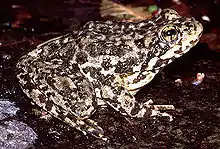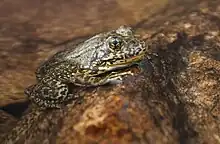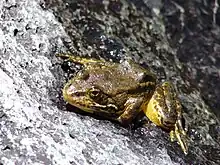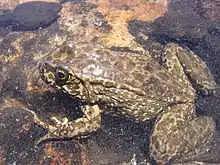| Mountain yellow-legged frog | |
|---|---|
 | |
| Scientific classification | |
| Domain: | Eukaryota |
| Kingdom: | Animalia |
| Phylum: | Chordata |
| Class: | Amphibia |
| Order: | Anura |
| Family: | Ranidae |
| Genus: | Rana |
| Species: | R. muscosa |
| Binomial name | |
| Rana muscosa Camp, 1917 | |
| Synonyms[2] | |
| |
The mountain yellow-legged frog (Rana muscosa), also known as the southern mountain yellow-legged frog, is a species of true frog endemic to California in the United States.[1][2] It occurs in the San Jacinto Mountains, San Bernardino Mountains, and San Gabriel Mountains in Southern California and the Southern Sierra Nevada. It is a federally listed endangered species,[3] separated into two distinct population segments (DPS): a northern DPS, listed endangered in 2014,[4] and a southern DPS that was listed endangered in 2002.[5]
Populations formerly classified as Rana muscosa in the northern Sierra Nevada have since been redescribed as a new species: Rana sierrae, the Sierra Nevada yellow-legged frog. The Sierra Nevada yellow-legged frog has also been classified as a federally endangered species since 2014.[4] The mountains separating the headwaters of the South Fork and Middle Fork of the Kings River mark the boundary between the ranges of the two species.[1]
Description

Rana muscosa is 4 to 8.9 centimetres (1.6 to 3.5 in) long. Females tend to be larger than males.[6] Its color and patterning are variable. It is yellowish, brownish, or olive with black and brown markings. The underside of its hind legs can be different hues of yellow, from a bold sun yellow to a lighter pale yellow; larger ones may can hints of orange on their hind legs. The throats of it range from white to yellow.[7] Along with its variable coloration, the frog also has a dorsal pattern with dark spots in different shapes and sizes. Its species name muscosa is from the Latin meaning "mossy" or "full of moss", inspired by its coloration. It may have light orange or yellow thighs. When handled, the frog emits a defensive odor reminiscent of garlic.[8]
Habitat
The frog occurs in mountain creeks, lakes and lakeshores, streams, and pools, preferring sunny areas. It rarely strays far from water, and can remain underwater for a very long time, likely through cutaneous gas exchange. As such, adults can be found on rocks around shorelines. Close proximity to water is important because eggs are either laid underwater attached to rocks or in shallow waters. The tadpoles require a permanent water habitat for at least two years while they develop. This is because tadpoles can die from a lack of moisture, especially dry summers. The frog has been noted at elevations of between about 1,214 and 7,546 feet (370 and 2,300 m) in Southern California.[1] These habitats are primarily found in north of California in Sierra Nevada and south of California in the Transverse ranges.
Reproduction and early life
.jpg.webp)
The frog emerges from its wintering site soon after snowmelt. Its breeding season begins once the highest meltwater flow is over, around March through May in the southern part of its range, and up to July in higher mountains to the north. Fertilization is external, and the egg cluster is secured to vegetation in a current, or in still waters sometimes left floating free. How long it takes for breeding onset varies from 1–4 years depending on the levels of snow and temperature. Very cold temperatures may cause death of larvae.[7] The juvenile may be a tadpole for 3 to 4 years before undergoing metamorphosis.[8] However, this rate heavily varies depending on the temperature and elevation of the area.[7] There are two classes of tadpoles: first year tadpoles and second year tadpoles. Metamorphosis tends to happen the second summer of tadpole life. They are called metamorphs when this transition from tadpole to young frog is occurring. They are then called a juvenile when it survives one winter. It becomes ready to reproduce after 2 years of the juvenile stage. It is found that the growth and development rate is slower at higher elevations.[7]
Behavior
The frog lacks a vocal sac. Its call is raspy, rising at the end. During the day, it calls underwater.[8] The frogs tend to be less active during the winters and more active during the mating season. For years when there is heavy snow at high elevations, they may only be active for 90 days in the summer.[7] Hibernation tends to happen underwater or in the crevices of stream banks. This occurs during the cold months of winter. Hibernation ends in the spring to start the breeding season.[3] This species feeds on aquatic insects and benthic invertebrates. Their diet varies depending on the habitat type. When living in streams, it tends to eat terrestrial insects such as beetles, ants, bees, wasps, flies, and dragonflies.[7] They are also known to eat larvae of other frogs and toads, as well as commit cannibalism.[8]
Decline

Once a common species, Rana muscosa was absent from much of its native range by the 1970s. Over the course of the last hundred years, 90% of its populations have been eliminated.[9] The frog was known from 166 locations in the Southern California mountains, and as of 2007, only seven or eight remained.[1] The 2009 discovery of R. muscosa at two locations in the San Bernardino National Forest was newsworthy.[10] The frog is represented in the Sierra Nevada by three or four populations.[1] Its decline is attributed to many factors, including introduced species of fish such as trout, livestock grazing,[11] chytrid fungus,[12] and probably pesticides, drought, and ultraviolet radiation.[11] Recreational activities in streams have also had an impact.[13]
Introduced fish species
Trout were introduced to lakes and streams throughout the Sierra Nevada in the late 1800s to increase recreational fishing in the area. 90% of these Sierra Nevada lakes and streams did not previously have fish in them, although the trout were regionally present.[14] The fish feed on tadpoles, a main prey item. Some of the fish types that prey on tadpoles include the brown, golden, and rainbow trout, as well as the brook char.[15] The introduced trout have changed the distribution of several native species in the local ecosystems.[9] Most of the mountain yellow-legged frog populations did not evolve to adapt to the trout. The trout caused populations to isolate, restricted the amount of available habitats, and increased the chances of extinction. After the removal of fish from several lakes, the frog reappeared and its populations increased.[9] These frogs then began to disperse to other suitable habitats nearby.[16]
Pesticides
The decline of the frog from its historic range has been associated with pesticide drift from agricultural areas.[17][18] Frogs that have been reintroduced to water bodies cleared of fish have failed to survive, and analysis has isolated pesticides in their tissues.[19] Pesticides are considered by some authorities to be a greater threat to the frog than the trout.[20] The relative roles that pesticides and introduced fish play in frog declines are still debated, and the loss of R. muscosa in its former range has probably been influenced by multiple factors.[19]
Chytridiomycosis

This species is one of many amphibians affected by the fungal disease chytridiomycosis. Ample research has explored the biology of the fungus and how to prevent related amphibian declines.[12] The fungus attacks keratinized areas of a frog's body. Tadpoles are not severely affected because only their jaw sheaths and tooth rows are heavily keratinized.[21] Infection in a tadpole can be identified by changes in the pigmentation of these parts.[22] Adults have keratin-rich skin and suffer worse infections.
In studies, healthy adult frogs exposed to infected frogs for at least two weeks developed the disease. Transmission takes longer in tadpoles, generally over seven weeks.[22] Frogs may be predisposed to infection if their immune systems are weakened by other factors, such as pesticide.[23] Studies indicate that R. muscosa is naturally more susceptible to the chytrid fungus than many other frogs.[24]
Conservation status and efforts
The frog is an endangered species under the US Endangered Species Act.[3] It is separated into two distinct population segments (DPS): a northern DPS, listed endangered since 2014,[4] and a southern DPS that was listed endangered in 2002.[5] The two DPS are separated by the Tehachapi Mountains, and occupy unique habitats: the northern DPS lives in lakes or slow-moving water bodies at alpine and subalpine elevations in the Sierra Nevada, while the southern DPS lives in faster flowing and warmer waters of the chaparral, although it may also occur at higher elevations in the Transverse Range.[4]: 24263–2464 In addition, the DPS show genetic divergence, likely reflecting ancient reproductive isolation.[4]: 24263–2464
The International Union for Conservation of Nature has also listed the mountain yellow-legged frog as endangered.[1] Its NatureServe conservation status is "critically imperiled."[25]
The first successful captive breeding of the frog occurred in 2009 when three tadpoles were reared at the San Diego Zoo. Conservation workers at the zoo plan to release any more surviving captive-bred frogs in the San Jacinto Mountains, part of their native range.[15][26]
In 2015 frogs and tadpoles of the species were reintroduced to Fuller Mill Creek in the San Bernardino Mountains and San Bernardino National Forest.[27] They were bred and raised the Arnold and Mabel Beckman Center for Conservation Research in Escondido, one of the organizations that have partnered with the San Diego Zoo Institute for Conservation Research (ICR) to save the species from extinction.[27] The Los Angeles Zoo is also a coalition partner and is raising two groups of wild collected tadpoles from two localities in the San Gabriel Mountains where they are released when ready.[27][28]
In 2015, the Oakland Zoo began a rehabilitation project of the frog in order to fuel efforts to save the species.[29] Every year, a group of tadpoles are taken from native lakes throughout California and brought to the zoo. There, the tadpoles are grown to juvenile frogs, while also undergoing an inoculation process to render them immune to the chytridiomycosis fungus disease. Once ready, the now chytrid immune juvenile frogs are released back into the lakes they were found. In 2016, the Oakland Zoo released 53 specimens into various lakes in Sequoia and Kings Canyon National Parks.[30] The program is set to release 130 inoculated individuals into lakes in Sequoia and Kings Canyon National Parks and Inyo National Forest in 2017.
In 2021, the Aquarium of the Pacific partnered with government organizations like the California Department of Fish and Wildlife to create a facility for taking care of mountain yellow-legged frogs. This was in response to recent wildfires which harmed their habitats. Following the wildfires, wildlife agencies found and moved these frogs into places like the facility established by the Aquarium of the Pacific. These efforts help the species recover from natural disasters and prevent extinction.[31][32]
References
- 1 2 3 4 5 6 7 IUCN SSC Amphibian Specialist Group (2022). "Rana muscosa". IUCN Red List of Threatened Species. 2022: e.T19177A118975294. Retrieved April 28, 2023.
- 1 2 Frost, Darrel R. (2021). "Rana muscosa Camp, 1917". Amphibian Species of the World: An Online Reference. Version 6.1. American Museum of Natural History. doi:10.5531/db.vz.0001. Retrieved February 16, 2021.
- 1 2 3 "Mountain yellow-legged frog (Rana muscosa)". Environmental Conservation Online System. U.S. Fish & Wildlife Service. Retrieved April 28, 2023.
- 1 2 3 4 5 79 FR 24256
- 1 2 67 FR 44382
- ↑ "Mountain Yellow-legged Frog (Rana muscosa) | U.S. Fish & Wildlife Service". FWS.gov. Retrieved October 21, 2022.
- 1 2 3 4 5 6 United States Department of Agriculture (2014). “MOUNTAIN YELLOW-LEGGED FROG CONSERVATION ASSESSMENT for the SIERRA NEVADA MOUNTAINS OF CALIFORNIA, USA.
- 1 2 3 4 Rana muscosa - Southern Mountain Yellow-legged Frog, California Herps: A Guide to the Amphibians and Reptiles of California. 2013.
- 1 2 3 Knapp, R. A., et al. (2007). "Removal of nonnative fish results in population expansion of a declining amphibian (mountain yellow-legged frog, Rana muscosa)' Biological Conservation 135(1):11-20.
- ↑ Discovery Channel (July 24, 2009). Nearly extinct California frog rediscovered. NBC News. Retrieved 28 April 2023.
- 1 2 Vredenburg, V. The Mountain Yellow-legged Frog - Can They be Saved? Archived 2019-04-20 at the Wayback Machine Sierra Nature Notes Volume 1. January, 2001.
- 1 2 The Amphibian Chytrid Fungus and Chytridiomycosis. Archived 2009-02-21 at the Wayback Machine Amphibianark.org. Retrieved 04 August 2013.
- ↑ Bailey, Tia (September 21, 2022). "Yellow-Legged Frogs To Be Reintroduced to San Gabriel Mountains". Outsider. Retrieved September 22, 2022.
- ↑ "Sierra Nevada Mountain Yellow-Legged Frog - Sierra Forest Legacy". www.sierraforestlegacy.org. Retrieved October 21, 2022.
- 1 2 Mountain Yellow-legged Frog Hopping for Survival. Archived 2013-05-13 at the Wayback Machine San Diego Zoo Global.
- ↑ Vredenburg, V. T. (2004). "Reversing introduced species effects: Experimental removal of introduced fish leads to rapid recovery of a declining frog". Proceedings of the National Academy of Sciences. 101 (20): 7646–7650. Bibcode:2004PNAS..101.7646V. doi:10.1073/pnas.0402321101. PMC 419660. PMID 15136741.
- ↑ Davidson, Carlos; Shaffer, H. Bradley & Jennings, Mark R. (2002). "Spatial tests of the pesticide drift, habitat destruction, UV-B, and climate-change hypotheses for California amphibian declines". Conservation Biology. 16 (6): 1588–1601. doi:10.1046/j.1523-1739.2002.01030.x. S2CID 8095186.
- ↑ Davidson, Carlos (2004). "Declining downwind: amphibian population declines in California and historical pesticide use". Ecological Applications. 14 (6): 1892–1902. doi:10.1890/03-5224.
- 1 2 Davidson, Carlos & Knapp, Roland A. (2007). "Multiple stressors and amphibian declines: dual impacts of pesticides and fish on yellow-legged frogs". Ecological Applications. 17 (2): 587–597. doi:10.1890/06-0181. PMID 17489262.
- ↑ Taylor, Sharon K.; Williams, Elizabeth S. & Mills, Ken W. (1999). "Effects of malathion on disease susceptibility in Woodhouse's toads". Journal of Wildlife Diseases. 35 (3): 536–541. doi:10.7589/0090-3558-35.3.536. PMID 10479088.
- ↑ Andre, Sara E.; Parker, John & Briggs, Cheryl J. (July 2008). "Effect of temperature on host response to Batrachochytrium dendrobatidis infection in the mountain yellow-legged frog (Rana muscosa)". Journal of Wildlife Diseases. 44 (3): 716–720. doi:10.7589/0090-3558-44.3.716. PMID 18689660. Archived 2013-08-05 at archive.today
- 1 2 Rachowicz, Lara J. & Vredenburg, Vance T. (2004). "Transmission of Batrachochytrium dendrobatidis within and between amphibian life stages" (PDF). Diseases of Aquatic Organisms. 61 (1–2): 75–83. doi:10.3354/dao061075. PMID 15584413.
- ↑ Rachowicz, Lara J.; Knapp, Roland A.; Morgan, Jess A. T.; Stice, Mary J.; Vredenburg, Vance T.; Parker, John M. & Briggs, Cheryl J. (July 2006). "Emerging infectious disease as a proximate cause of amphibian mass mortality" (PDF). Ecology. 87 (7): 1671–1683. doi:10.1890/0012-9658(2006)87[1671:EIDAAP]2.0.CO;2. PMID 16922318.
- ↑ Rollins-Smith, Louise A.; Woodhams, Douglas C.; Reinert, Laura K.; Vredenburg, Vance T.; Briggs, Cheryl J.; Nielsen, Per F. & Michael Conlon, J. (January 2006). "Antimicrobial peptide defenses of the mountain yellow-legged frog (Rana muscosa)" (PDF). Developmental & Comparative Immunology. 30 (9): 831–842. doi:10.1016/j.dci.2005.10.005. PMID 16330099.
- ↑ NatureServe (April 7, 2023). "Rana muscosa". NatureServe Network Biodiversity Location Data accessed through NatureServe Explorer. Arlington, Virginia: NatureServe. Retrieved April 28, 2023.
- ↑ "Precious Cargo: Brighter Future For 100 Juvenile Mountain Yellow Legged Frogs, Tadpoles". U.S. Fish and Wildlife Service. November 7, 2016. Retrieved January 1, 2017.
- 1 2 3 SoCal Wild.com: "Building a Mountain Frogtown for Yellow-Legged Frogs"; Brenda Rees, editor; 10 August 2015.
- ↑ Sahagun, Louis (August 15, 2019). "Meet the 'rock star' frog breeder vying to save Southern California's rarest amphibian". Los Angeles Times. Retrieved August 20, 2019.
- ↑ "Oakland Zoo". www.oaklandzoo.org. Archived from the original on July 30, 2017. Retrieved July 13, 2017.
- ↑ "From the Brink of Extinction: Oakland Zoo Releases Critically Endangered Frogs into the Wild : The Outdoor Wire". www.theoutdoorwire.com. Retrieved July 13, 2017.
- ↑ Aquarium of the Pacific. "Mountain Yellow-Legged Frog". www.aquariumofpacific.org. Retrieved October 19, 2022.
- ↑ "Mountain Yellow-legged Frog (Rana muscosa) | U.S. Fish & Wildlife Service". FWS.gov. Retrieved October 19, 2022.
Further reading
- Adams, M. J., et al. (2005). Distribution patterns of lentic-breeding amphibians in relation to ultraviolet radiation exposure in western North America. Ecosystems 8(5):488-500.
- Bridges, C. M. and M. D. Boone. (2003). The interactive effects of UV-B and insecticide exposure on tadpole survival, growth and development. Biological Conservation 113(1):49-54.
- Briggs, C. J., et al. (2005). Investigating the population-level effects of chytridiomycosis: an emerging infectious disease of amphibians. Ecology 86(12):3149-59.
- Funk, W. C. and W. W. Dunlap. (1999). Colonization of high-elevation lakes by long-toed salamanders (Ambystoma macrodactylum) after the extinction of introduced trout populations. Canadian Journal of Zoology 77(11):1759-67. (abstract)
- Hillis, D. M. and T. P. Wilcox. (2005). Phylogeny of the New World true frogs (Rana). Molecular Phylogenetics and Evolution 34(2):299-314.
- Hillis, D. M. (2007). Constraints in naming parts of the Tree of Life. Molecular Phylogenetics and Evolution 42(2):331-38.
- Knapp, R. A. and K. R. Matthews. (2000). Non-native fish introductions and the decline of the mountain yellow-legged frog from within protected areas. Conservation Biology 14(2), 428–38.
- Pister, E. P. (2001). Wilderness fish stocking: history and perspective. Ecosystems 4(4):279-86.
- Stuart, S. N., et al. (2004). Status and trends of amphibian declines and extinctions worldwide. Science 306(5702):1783-86.
- Vredenburg, V. T., et al. (2007). Concordant molecular and phenotypic data delineate new taxonomy and conservation priorities for the endangered mountain yellow-legged frog (Ranidae: Rana muscosa). Journal of Zoology 271:361-74.
External links
![]() Data related to Rana muscosa at Wikispecies
Data related to Rana muscosa at Wikispecies
- Fisher, R. N. and T. J. Case. (2003). Rana muscosa, A Field Guide to the Reptiles and Amphibians of Coastal Southern California. USGS.
- The Mountain Yellow-legged Frog Site.
- Rana muscosa, AmphibiaWeb.
- Rana muscosa vocalizations, Western Soundscape Archive.
- Mountain Yellow Legged Frog Release
- "Mountain Yellow-legged Frogs - Sequoia & Kings Canyon National Parks (U.S. National Park Service)". www.nps.gov. Retrieved October 19, 2022.
